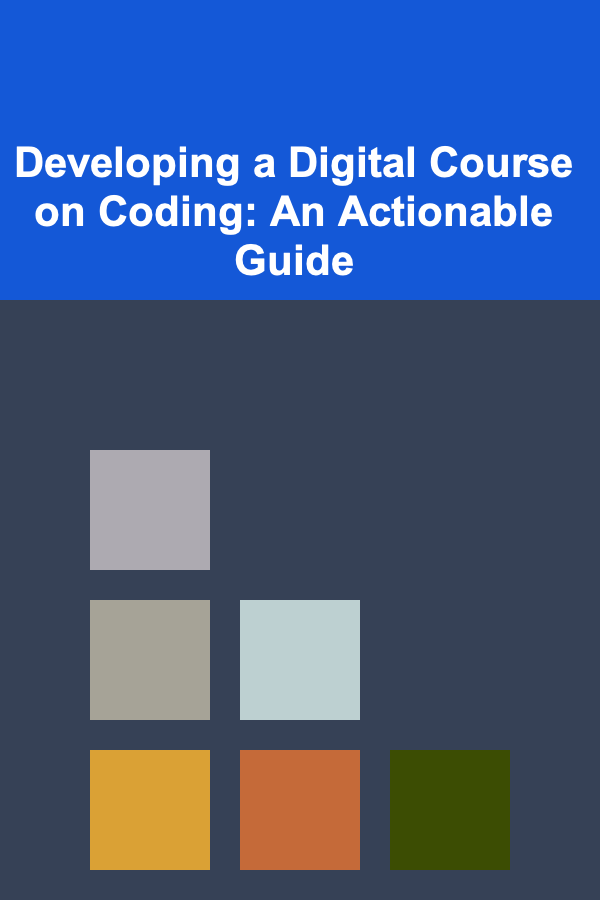
Developing a Digital Course on Coding: An Actionable Guide
ebook include PDF & Audio bundle (Micro Guide)
$12.99$7.99
Limited Time Offer! Order within the next:

Creating a digital course on coding can be a highly rewarding venture. Whether you're an educator, a tech professional, or an aspiring entrepreneur, there is a growing demand for coding courses, especially as the tech industry continues to expand. However, building an online course that is not only informative but also engaging requires careful planning, thoughtful execution, and consistent follow-up.
This guide will walk you through the process of creating a high-quality digital course on coding, from ideation to promotion, providing actionable steps and strategies to ensure its success.
Understanding the Market and Identifying Your Niche
Before diving into course creation, it's crucial to assess the landscape. Coding is a broad field, and you'll need to identify which areas you'll focus on. The first step is understanding the market demand and choosing a niche that aligns with both your expertise and the needs of potential learners.
Market Research
Begin by conducting thorough market research. Here are some key questions to guide your research:
- Who is your target audience? Are you catering to beginners, intermediate learners, or advanced coders? Will your course focus on kids, young adults, professionals, or hobbyists?
- What coding languages or frameworks are in demand? Popular languages such as Python, JavaScript, and SQL are often in demand. Consider which languages or technologies will be the focus of your course.
- What are your competitors offering? Research existing coding courses on platforms like Udemy, Coursera, or Skillshare. Take note of their content, format, pricing, and feedback. What can you do differently to stand out?
- What problems are learners facing? Use online forums, blogs, and social media groups to identify the challenges students encounter while learning to code. You can then tailor your course to solve these pain points.
Choosing Your Niche
Once you have your research, narrow your focus to a specific niche. For example:
- Languages: Python, JavaScript, C++, etc.
- Applications: Web development, game development, data science, mobile app development, etc.
- Target Audience: Beginner coders, children, professionals transitioning careers, etc.
Focusing on a niche allows you to cater to a specific audience and stand out from the crowded coding course market.
Structuring Your Course Content
Creating a digital course on coding is more than just providing tutorials. The structure of your course plays a crucial role in how students will engage with and learn from your material.
Define Clear Learning Outcomes
Before developing content, define the learning outcomes of your course. What should students be able to do by the end? For example:
- "By the end of this course, students will be able to build their own interactive websites using HTML, CSS, and JavaScript."
- "By the end of this course, students will be able to apply Python to solve real-world data analysis problems."
Make sure these outcomes are specific, measurable, and aligned with the content you're teaching.
Break Down the Curriculum
Organize your course into manageable sections or modules. Each module should focus on a specific topic or skill. Break down the material into bite-sized pieces to avoid overwhelming your students.
Example Course Structure (for a Python for Beginners course):
-
Introduction to Python
- What is Python?
- Installing Python
- Writing Your First Python Program
- Basic Syntax and Data Types
-
Control Flow and Loops
- Conditional Statements (if/else)
- Loops (for, while)
- Practical Examples
-
Functions and Modules
- Defining Functions
- Using Built-In Modules
- Creating Your Own Modules
-
Data Structures in Python
- Lists, Tuples, and Dictionaries
- Working with Arrays
-
Object-Oriented Programming (OOP)
- Introduction to Classes and Objects
- Inheritance, Polymorphism, and Encapsulation
-
Final Project
- Building a Simple Python Application
Balance Theory and Practice
A good coding course should include both theory (explanations of concepts) and practice (hands-on coding exercises). A purely theoretical course won't engage learners, while a course made up entirely of exercises might be too challenging for beginners.
Include Quizzes and Assessments
To reinforce learning, include quizzes and assessments at the end of each module. This helps students check their understanding and retain the material. The assessments should be varied:
- Multiple Choice: To test knowledge on coding concepts.
- Coding Challenges: To assess practical application of skills learned.
- Project-Based Assessments: A final project that allows students to demonstrate their skills in a real-world context.
Choosing the Right Tools and Platform
The platform you choose for delivering your course plays a significant role in the learner's experience. Depending on your needs, you can either build a custom course website or host your course on an established learning platform.
Learning Management Systems (LMS)
Several Learning Management Systems (LMS) allow you to create and sell courses without much technical setup. Popular LMS platforms include:
- Teachable: An easy-to-use platform with integrated marketing tools, great for beginners.
- Thinkific: Offers a range of customizable templates for creating professional-looking courses.
- Udemy: A massive platform with built-in marketing, but with a revenue-sharing model.
- Kajabi: Known for its robust marketing and automation tools.
Video Recording and Editing Tools
Video content is crucial in coding courses, especially for step-by-step coding tutorials. For creating high-quality videos, consider these tools:
- Screen Recording Software: OBS Studio, Camtasia, or Loom for recording your screen and explaining the code.
- Editing Software: Adobe Premiere Pro, Final Cut Pro, or simpler options like iMovie and Shotcut for video editing.
Code Collaboration Platforms
For interactive learning, you may want to integrate live coding environments or platforms where students can practice coding:
- Replit: An online IDE that allows students to code directly within the browser.
- Glitch: Great for building web apps collaboratively in real-time.
- GitHub: Useful for version control and sharing projects. It's also a great platform for hosting your course's code examples.
Producing High-Quality Content
Creating high-quality, engaging content is key to the success of your course. The following are some tips for creating content that will keep students interested:
1. Engaging Videos
Coding can be complex, so using engaging video content is essential. Keep the videos short (10-15 minutes), to the point, and interactive. Use screen recordings to show your students exactly what you're doing on the computer.
- Tips for Effective Coding Videos:
- Use a mix of narration and on-screen text for clarity.
- Highlight your cursor or key areas of the screen you're working on.
- Break down the code step by step and explain each concept.
2. Code Examples and Exercises
Include plenty of code examples that students can copy and paste into their own coding environments. Always explain what the code does and why it's important.
- Interactive Challenges: Challenge students to solve problems on their own by providing them with partial code or asking them to complete small coding exercises.
3. Document the Code
Make sure that all of the code in your course is well-commented and explained. This will help learners understand the thought process behind the code, making it easier for them to follow along.
Marketing and Selling Your Course
Once your course is ready, it's time to promote and sell it. Effective marketing is key to reaching your target audience.
Build a Landing Page
Create a compelling landing page for your course that highlights its value proposition. Include:
- A catchy title and description
- Key benefits of taking the course
- Testimonials (if available)
- A call to action (CTA) encouraging visitors to enroll
Social Media and Content Marketing
Leverage social media platforms like LinkedIn, Twitter, Facebook, and Instagram to market your course. Share coding tips, snippets from your course, and student success stories.
- Start a blog or YouTube channel to share free, valuable content to build credibility and attract learners.
- Engage with coding communities like StackOverflow, Reddit, and coding-focused Facebook groups.
Offer Promotions and Discounts
Offer limited-time discounts or early-bird pricing to attract initial customers. You can also provide incentives for referrals or offer bonus content for students who enroll early.
Build an Email List
Start building an email list from day one. Offer a free resource (e.g., coding cheat sheets or an introductory lesson) in exchange for email sign-ups. Use email marketing to send updates, special offers, and course content.
Continuous Improvement and Updates
After launching the course, monitor feedback from students and continue improving your content. Coding technologies evolve rapidly, so it's essential to update your course regularly with the latest trends, tools, and techniques.
Collect Feedback
Encourage students to provide feedback on the course. Use surveys, direct emails, and community forums to gather insights. This will help you identify areas for improvement.
Stay Relevant
Keep your course up to date with the latest coding trends, libraries, and frameworks. Add new modules or bonus content regularly to keep students engaged and coming back for more.
Conclusion
Developing a digital course on coding is a rewarding challenge, but with proper planning, structure, and marketing, it can become a highly successful endeavor. By focusing on creating clear learning outcomes, delivering engaging content, and using the right tools, you can provide an educational experience that helps students learn valuable coding skills while setting your course apart in a competitive market. Stay committed to continuous improvement, and you'll create a course that not only teaches coding but inspires future developers.
Reading More From Our Other Websites
- [Home Lighting 101] How to Create a Cozy, Hygge-Inspired Home with Lighting
- [Organization Tip 101] How to Keep Track of Your Hobby Expenses Efficiently
- [Home Pet Care 101] Pet-Friendly Car Essentials for Safe and Comfortable Travel
- [Home Family Activity 101] How to Organize a Family Fashion Show at Home
- [Home Budget Decorating 101] How to DIY Cheap Decorations for Your Room on a Tight Budget
- [Personal Care Tips 101] How to Use Cuticle Oil to Reduce Nail Fungus
- [Personal Financial Planning 101] How to Use the Best Money Management Apps to Track and Grow Your Finances
- [Personal Care Tips 101] How to Apply Makeup Primer for Long-Lasting Makeup
- [Organization Tip 101] How to Utilize Under-Bed Storage Effectively
- [Small Business 101] How to Set Up a Pop‑Up Retail Experience for a Handmade Candle Business During Holiday Seasons

How to Plan Fun and Engaging Activities for Seniors
Read More
How to Save Space in Your Bathroom with Clever Storage Hacks
Read More
How to Sell Your Antique Books Through an Online Marketplace
Read More
How to Store Seasonal Items Without Taking Up Too Much Space
Read More
The Art Director's Guide: Leading Creative Teams and Designing Stunning Visuals
Read More
10 Tips for Cultivating Your Own Cheese Cultures
Read MoreOther Products

How to Plan Fun and Engaging Activities for Seniors
Read More
How to Save Space in Your Bathroom with Clever Storage Hacks
Read More
How to Sell Your Antique Books Through an Online Marketplace
Read More
How to Store Seasonal Items Without Taking Up Too Much Space
Read More
The Art Director's Guide: Leading Creative Teams and Designing Stunning Visuals
Read More